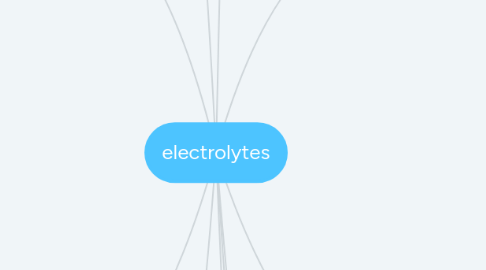
1. Mg
1.1. general
1.2. hypomagnesemia
1.2.1. s/s
1.2.2. Dx
1.2.3. Tx
1.2.3.1. FNP
1.2.3.2. RN
1.3. hypermagnesemia
1.3.1. s/s
1.3.2. Dx
1.3.3. Tx
1.3.3.1. FNP
1.3.3.2. RN
2. +/-
2.1. cations
2.1.1. Na+
2.1.2. K+
2.1.3. Ca+
2.2. anions
2.2.1. -
2.2.1.1. Cl-
2.2.1.2. Bicarbonate
3. fluids
3.1. imbalance
3.1.1. overload
3.1.1.1. general
3.1.1.1.1. dilution ECF
3.1.1.1.2. water into ICF
3.1.1.1.3. causes
3.1.1.2. s/s
3.1.1.2.1. edma
3.1.1.2.2. JVD
3.1.1.2.3. SOB
3.1.1.2.4. wt gain
3.1.1.2.5. cramping
3.1.1.2.6. Dx findings
3.1.2. deficit
3.1.2.1. causes
3.1.2.1.1. perspiration
3.1.2.1.2. dibetes insipidus
3.1.2.1.3. diuresis
3.1.2.1.4. hemorrhage
3.1.2.1.5. GI loses
3.1.2.1.6. third spacing
3.1.2.2. s/s
3.1.2.2.1. sunken eyes, dry tongue
3.1.2.2.2. tachycardia, thready pulse
3.1.2.2.3. tachypnea, post hypotension
3.1.2.2.4. lethargy to coma
3.1.2.2.5. absent tearing or sweating
3.1.2.2.6. oliguria
4. minerals
4.1. Fe
4.2. iodine
4.3. zinc
5. Na+
5.1. general
5.1.1. functions
5.1.1.1. 90% ECF
5.1.1.2. anions - CL- and bicarb
5.1.1.3. nerve impulses w/K and Ca
5.1.1.4. acid/base balance
5.1.1.5. cellular chemical reactions
5.1.1.6. membrane transport
5.1.1.7. maintains BP
5.1.2. control
5.1.2.1. brain/thirst
5.1.2.2. hypothalamus
5.1.2.2.1. pituitary gland
5.1.2.3. kidneys
5.1.2.3.1. dcr Na osmolality
5.1.2.4. aldosterone
5.1.2.4.1. Na reabsorption
5.2. hyponatremia
5.2.1. manage
5.2.1.1. s/s
5.2.1.1.1. lethargy -> confusion -> seizures -> coma
5.2.1.1.2. headache, apprehension, tremors
5.2.1.1.3. IV fluid overload, hyperglycemia, SIADH, ht failure, GI drainage, V&D
5.2.1.1.4. wt loss
5.2.1.1.5. dry mucous membranes
5.2.1.2. Dx/findings
5.2.1.2.1. Na+ < 135 mEq/L
5.2.1.2.2. dcr CVP, dcr JV filling
5.2.1.2.3. urine spec grav < 1.010
5.2.1.3. Tx
5.2.1.3.1. FNP
5.2.1.3.2. RN
6. Na + K
7. K
7.1. general
7.1.1. functions
7.1.1.1. cellular fluid balance
7.1.1.2. muscle contaction
7.1.1.3. carb fat breakdown
7.1.1.4. cell growth
7.1.1.5. acid/base balance
7.1.2. control
7.1.2.1. kidneys
7.1.2.2. aldosterone
7.1.2.2.1. leave ECF and excrete
7.1.2.3. insulin dcr
7.2. hyperkalemia
7.2.1. manage
7.2.1.1. s/s
7.2.1.1.1. M(muscle weakness, U(urine oliguria), R(respiratory distress), D(decreased cardiac contractility), E(ECG changes), R(reflexes, hyper, flaccidity)
7.2.1.2. Dx/findings
7.2.1.2.1. >5.5 mEq/L
7.2.1.2.2. M(meds, NSAIDs, ACE inhibitors)
7.2.1.2.3. A(acidosis)
7.2.1.2.4. C (cellular destruction)
7.2.1.2.5. H(hypoaldosteronism, hemolysis)
7.2.1.2.6. Nephron (failure)
7.2.1.2.7. E(excretion, impaired)
7.2.1.3. Tx
7.2.1.3.1. FNP
7.2.1.3.2. RN
7.3. hypokalemia
7.3.1. manage
7.3.1.1. s/s
7.3.1.1.1. fatigue, weakness, leg cramps
7.3.1.1.2. weak, irreg pulse
7.3.1.1.3. hyperglycemia
7.3.1.1.4. decreased GI motility
7.3.1.1.5. bradycardia
7.3.1.1.6. ECG changes
7.3.1.2. Dx/findings
7.3.1.2.1. <3.5 mEq/L
7.3.1.3. Tx
7.3.1.3.1. FNP
7.3.1.3.2. RN
8. Ca
8.1. general
8.2. hypocalcemia
8.2.1. s/s
8.2.2. Dx
8.2.3. Tx
8.2.3.1. FNP
8.2.3.2. RN
8.3. hypercalcemia
8.3.1. s/s
8.3.2. Dx
8.3.3. Tx
8.3.3.1. FNP
8.3.3.2. RN
9. Ca + P
9.1. Ca + P + Mg
9.1.1. may all go together
10. P
10.1. general
10.2. hypophosphatemia
10.2.1. s/s
10.2.2. Dx/findings
10.2.3. Tx
10.2.3.1. FNP
10.2.3.2. RN
10.3. hyperphosphatemia
10.3.1. s/s
10.3.2. Dx
10.3.3. Tx
10.3.3.1. FNP
10.3.3.2. RN
